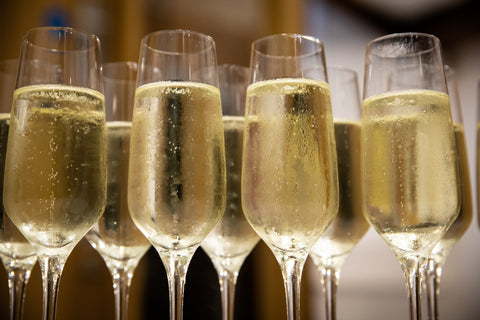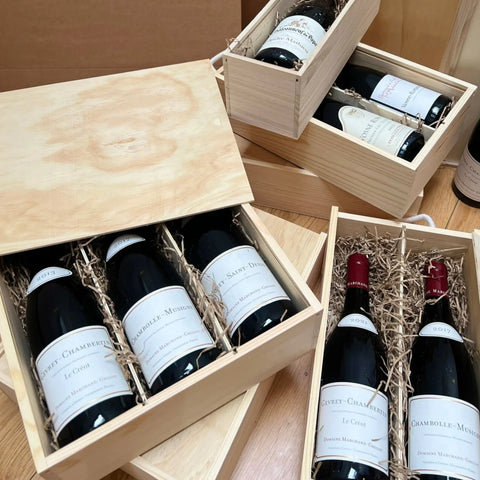What is Orange Wine?
I have to admit to being a bit of a latecomer to the joys of Orange wine - I think largely because my first sips were of bottles that were out of balance, poorly made and frankly rather unpleasant.
Then, many sips of many bottles later, and a meal full of hard-to-pair foods such as sushi with ginger and soy or Korean pork with kimchi, and a bottle of really well made Orange wine, I finally got it.
How is Orange wine made?
Orange wine does not contain oranges. It is made from 100% grapes and only takes its name from its colour.
It is essentially made in the same way as red wine, (although using white grapes).
The usual way to make white wine is to press the juice and to discard the skins and pips before fermenting the wine. Orange wine is made by leaving the juice of white grapes with its skins and pips before fermenting – which is what gives it its distinctive colour and taste.
The length of time that the skins and pips are left to ferment with the juice depends on the winemaker but varies from just a few days, to several months in some cases. It is fashionable now to refer to this as 'skin contact' wine. Not all 'skin contact' wine is orange, but all Orange wine is made using skin contact.
Rosé wine is, of course, made by leaving the white grape juice in contact with its red skins - only touching the liquid long enough to provide a pretty pink colour.
Orange wine is made from prolonged skin contact and will produce an array of flavours, aromas and textures to the finished wine.
Grape skins contain natural sulphurs and yeasts, so wines made in this way need very little else to help them ferment making them attractive to the 'natural' wine movement. This is a topic for a whole other blog but whatever your views, we recommend finding out for yourself why it's currently proving so popular across the wine drinking world.
What does Orange Wine taste like?
As it is essentially made in the same way as red wine, (although using white grapes) it also contains the tannins and nutty notes that you might associate with these, rather than the lighter textures and aromas found in white wines. It's been associated with Sherry like flavours - and often has honey overtones (not sweetness) with plenty of nuttiness and fresh fruit flavours which are influenced by the white grape variety used in its production.
Is Orange Wine sweet?
Orange wine has a reputation for being sweeter than a dry white wine, however this again is not the case. Tradition and grape variety dictates the finished product alongside the local market - so in some parts of the world, the wine may be fermented leaving more residual sugar, giving it a sweeter finish. Our Orange Wine from the fabulous Vignerons Landais is dry as a bone and full of fresh, crisp fruit flavours and a delicious nutty quality.
What to eat with Orange Wine
Orange wine, is a perfect gap-filler of a wine. Serve it icy cold and drink as an aperitif - on its own, or better still, with lots of salty or spicy snacks. Salted nuts will pick up on the nutty flavours of the wine, it will stand up to the bitterness in olives, and isn't at all bad with sharp cheeses.
It also works well with Japanese and Korean food and the range of complex salt, sharp, acid flavours which predominate in these cuisines.
On the fishy theme - we have tried it with both flash-roasted salmon and griddled tuna, cooked with plenty of garlic and lemon, all things that can be hard to match but that worked like a dream with our Vin Orange Gros Manseng VdF from La Cave des Vignerons Landais.
I often break the rules and drink a good Riesling with Indian food - but recently have found Orange Wine to be an excellent alternative and there's omething about the combination of salt and sweet, soft plump apricots with tangy tagines, which embraces both the freshness of the wine and its slightly bitter, tannin overtones.
What are the origins of Orange Wine?
Orange Wine is not new - but one of the oldest methods of wine making and has comparable wines across the wine making world.
Purportedly the oldest wines discovered to date, were made in Georgia in around 6000BC by putting white grapes into underground clay containers, lined with beeswax, and allowing them to ferment.
Other ancient examples can be found in Slovenia and Fruili in Italy and the well loved ‘Vin Jaune’ from the Jura in France is also made in this way.
(Think of the Vin Jaune in the Jura for example)
It feels new however, as it is only in recent years that young winemakers from a wider global context have experimented with the method using a range of grape varieties suited to their particular winery.
What colour is Orange wine?
Although the wine takes its name from its colour, Orange wines are not so much orange as a sort of deep amber, that varies according to the grape variety and length of time it is left to macerate in the skins.
Challenging our perceptions
Ultimately, enjoying wine is all about trying new things and continually challenging our perceptions, while recognising the wines and food pairings we prefer. If you haven't yet given Orange wine a run for its money, put a bottle of our Gros Maseng Orange wine from South West France in your basket and put it through its paces.





Comments (0)
There are no comments for this article. Be the first one to leave a message!